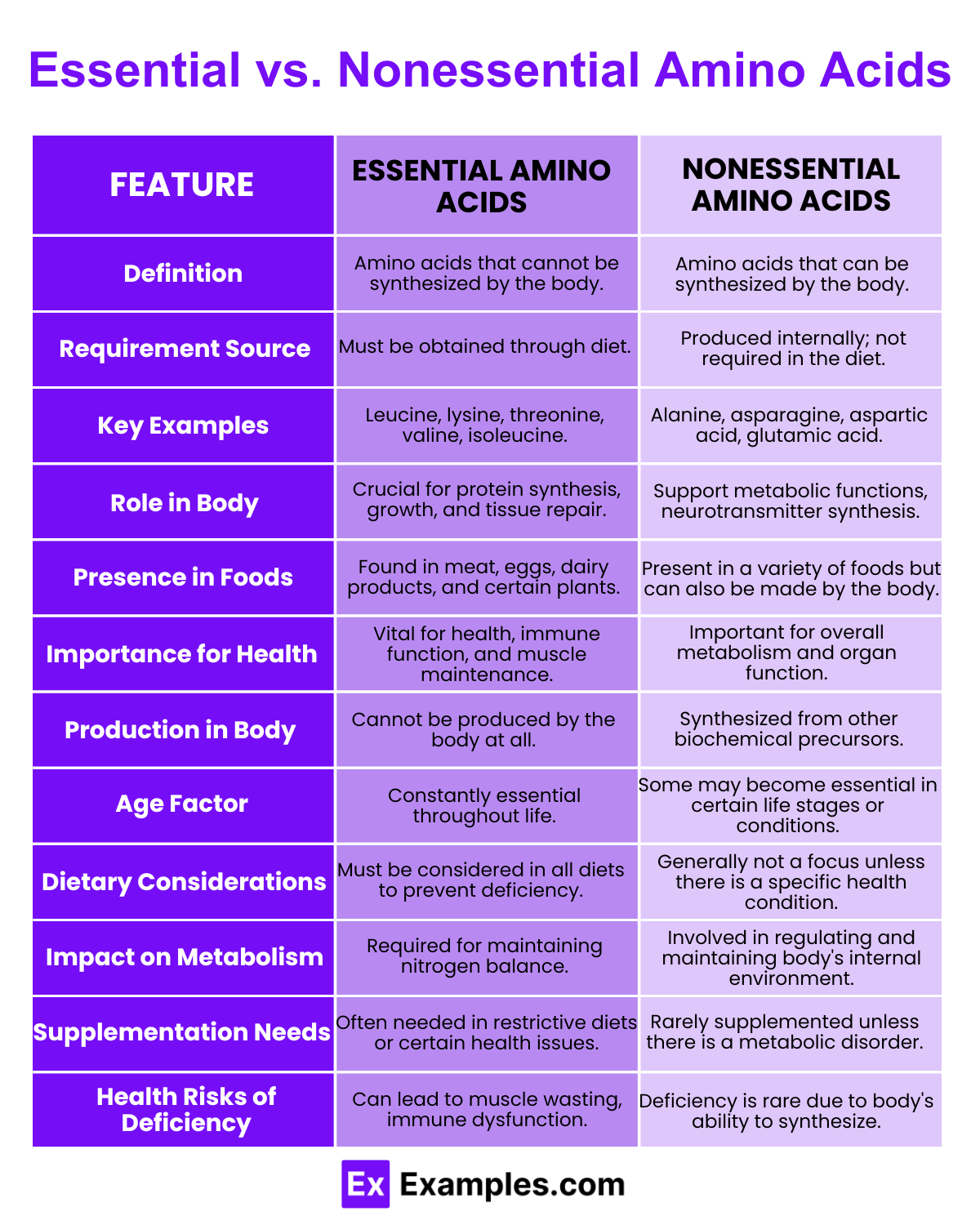Which of the following is an essential amino acid?
Glycine
Alanine
Lysine
Serine


Amino acids, the building blocks of proteins, play a crucial role in various biological processes. They fall into two categories: essential and nonessential amino acids. Essential amino acids cannot be synthesized by the human body and must be obtained through diet. These include histidine, isoleucine, leucine, lysine, methionine, phenylalanine, threonine, tryptophan, and valine. On the other hand, nonessential amino acids are those that the body can produce on its own, even if we do not consume them in our diet.
Essential amino acids are crucial for various bodily functions, including protein synthesis, tissue repair, and nutrient absorption. Unlike non-essential amino acids, which can be synthesized by the human body, essential amino acids must be obtained through diet. This article explores the nine essential amino acids, their roles, and dietary sources to help you understand their importance in maintaining health and well-being.
There are nine amino acids classified as essential for humans:
Essential amino acids are found in various animal and plant-based proteins. For optimal health, a balanced intake from diverse food sources is recommended:
Non-essential amino acids are amino acids that the body can synthesize on its own, meaning it is not essential to obtain them through the diet. However, they are still crucial for overall health and wellness, supporting numerous biological functions such as protein synthesis, enzyme production, and metabolism. This article delves into the various non-essential amino acids, their roles, and their importance in the human body.
The human body can produce 11 non-essential amino acids:
While the body can synthesize non-essential amino acids, obtaining them from the diet can play a supportive role, especially under stress or illness. Foods rich in protein typically provide both essential and non-essential amino acids. Sources include:

| Feature | Essential Amino Acids | Nonessential Amino Acids |
|---|---|---|
| Definition | Amino acids that the body cannot synthesize on its own and must be obtained through the diet. | Amino acids that the body can synthesize on its own, even if they are not supplied by the diet. |
| Examples | Histidine, Isoleucine, Leucine, Lysine, Methionine, Phenylalanine, Threonine, Tryptophan, Valine. | Alanine, Asparagine, Aspartic acid, Glutamic acid, Serine. |
| Dietary Importance | Must be consumed through food sources like meat, eggs, dairy products, and certain plant-based foods. | Typically do not need to be obtained through diet as the body can produce them from other compounds. |
| Synthesis in the Body | Cannot be synthesized in the body. | Can be synthesized in the body from other amino acids or through various metabolic pathways. |
| Role in Nutrition | Critical for maintaining good health and must be balanced within the diet. | Important for overall health but do not require dietary intake to be maintained. |
| Supplementation Required | Often required in cases of restricted diets or certain health conditions. | Rarely required as supplements unless specific metabolic disorders demand it. |
| Biosynthetic Pathways | None in humans; these amino acids must come from external sources. | Involve complex biochemical pathways that utilize nitrogen and carbon skeletons from other sources. |
| Impact on Growth and Repair | Vital for growth, tissue repair, and enzyme production. | Support various physiological functions, including neurotransmitter synthesis and detoxification. |
| Metabolic Role | Integral to protein synthesis and energy production during metabolic stress. | Play a role in regulating gene expression, antioxidant synthesis, and immune response. |
| Conditionally Essential | Certain conditions like illness or stress may increase the need for more of these through the diet. | Some can become essential under specific circumstances such as disease or severe stress. |
Despite their differences, essential and nonessential amino acids share several important similarities that underscore their critical roles in biological processes:
Essential amino acids cannot be synthesized by the body, while non-essential amino acids can be produced internally.
The nine essential amino acids are histidine, isoleucine, leucine, lysine, methionine, phenylalanine, threonine, tryptophan, and valine.
Essential fatty acids must be obtained from the diet, whereas non-essential fatty acids can be synthesized by the body.
The body synthesizes nonessential amino acids through various metabolic pathways using other amino acids and compounds.
A deficiency in essential amino acids can lead to muscle loss, weakened immune response, and impaired body functions.
Text prompt
Add Tone
10 Examples of Public speaking
20 Examples of Gas lighting
Which of the following is an essential amino acid?
Glycine
Alanine
Lysine
Serine
Nonessential amino acids:
Cannot be synthesized by the body
Must be obtained through the diet
Can be synthesized by the body
Are not found in proteins
Which of the following amino acids is nonessential?
Valine
Threonine
Leucine
Glutamine
Phenylalanine is classified as:
Essential
Nonessential
Conditionally essential
Non-proteinogenic
Which amino acid is essential for infants but not necessarily for adults?
Histidine
Tyrosine
Cysteine
Proline
The term "conditionally essential amino acids" refers to:
Amino acids that are always essential
Amino acids that are never essential
Amino acids that become essential under certain conditions
Amino acids that are only essential during infancy
Which of the following amino acids is conditionally essential?
Methionine
Arginine
Tryptophan
Valine
How many essential amino acids are there for humans?
5
9
11
20
Which of these amino acids is NOT essential?
Isoleucine
Methionine
Tyrosine
Tryptophan
The amino acid leucine is categorized as:
Essential
Nonessential
Conditionally essential
Non-proteinogenic
Before you leave, take our quick quiz to enhance your learning!

